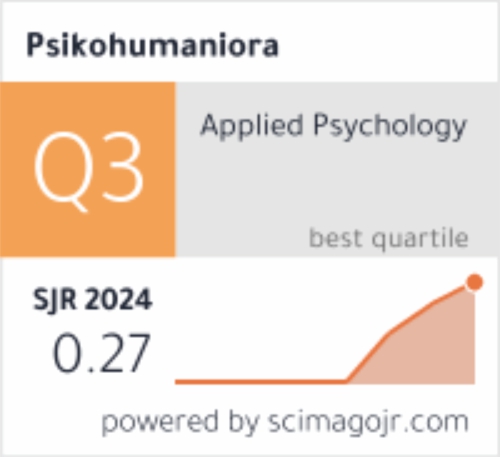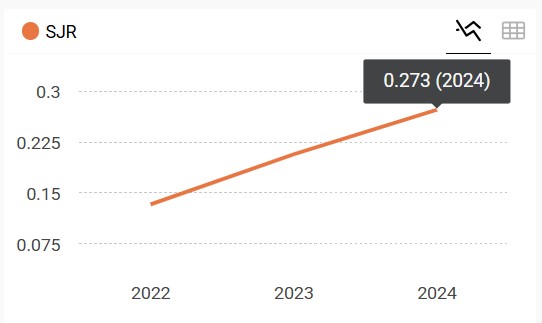The influence of socioeconomic status on job and life satisfaction among low-income employees in Johor Local Authorities
DOI:
https://doi.org/10.21580/pjpp.v6i2.8304Keywords:
job satisfaction, life satisfaction, low-income employees, socioeconomic status, well-beingAbstract
Many studies have found that a low socioeconomic status has a negative impact on welfare. However, contextual evidence on this issue in Malaysia is scarce. Therefore, this study attempts to quantitatively examine the effect of socioeconomic status on life and job satisfaction among low-income employees working in the public. The Satisfaction with Life Scale (SWLS), Work Domain Satisfaction Scale (WDSS), and Socioeconomic Questionnaire were presented to 265 respondents chosen using a convenience sampling technique. The data were then analyzed using SPSS 26.0 and SmartPLS 3.0 equation modeling. The results show that socioeconomic status had a positive effect on life satisfaction (t = 4.581; p < .001) and job satisfaction (t = 3.423; p < .001). Thus, this study contributes to the provision of better insights into the socioeconomic status factors that determine life and job satisfaction, especially among low-income employees working in the public sector in Malaysia.
Downloads
References
Aranda, M. P., & Lincoln, K. D. (2011). Financial strain, negative interaction, coping styles, and mental health among low-income Latinos. Race and Social Problems, 3(4), 280–297. https://doi.org/10.1007/s12552-011-9060-4
Baynham, J. L. E. (2015). A study: Income and happiness across Europe: Do reference value matter? Journal of Economic Psychology, 30(1), 42–51.
Bérubé, N., Donia, M. B. L., Gagné, M., Houlfort, N., & Lvina, E. (2016). Validation evidence for the Work Domain Satisfaction Scale in two languages. International Journal of Psychological Studies, 8(3), 26. https://doi.org/10.5539/ijps.v8n3p26
Bodeker, G., Pecorelli, S., Choy, L., & Guerra, R. (2020). Well-being and mental Wellness (Issue August). Oxford University Press. https://doi.org/10.1093/acrefore/9780190632366.013.162
Cohen, J. (1988). Statistical Power Analysis for the Behavioral Sciences (2nd ed.). Lawrence Erlbaum Associates.
Corporate Malaysia. (2017). B40 group to contribute 20% of GNI. https://themalaysianreserve.com/2017/04/03/b40-group-to-contribute-20-of-gni/
Deci, E. L., & Ryan, R. M. (2008). Hedonia, eudaimonia, and well-being: An introduction. Journal of Happiness Studies, 9(1), 1–11. https://doi.org/10.1007/s10902-006-9018-1
Department of Statistics Malaysia. (2017a). Household Income and Expenditure Survey. https://www.dosm.gov.my/v1/index.php?r=column/ctwoByCat&parent_id=119&menu_id=amVoWU54UTl0a21NWmdhMjFMMWcyZz09
Department of Statistics Malaysia. (2017b). Press Release: GDP by State 2016. https://www.dosm.gov.my/v1/index.php?r=column/pdfPrev&id=VS9Gckp1UUpKQUFWS1JHUnJZS2xzdz09
Department of Statistics Malaysia. (2019). Press Release: Malaysian Well-Being Index 2018. https://doi.org/10.1017/CBO9781107415324.004
Diener, E. (1984). Subjective well-being. Psychological Bulletin, 95, 542–575.
Diener, E., Emmons, R. A., Larsen, R. J., & Griffin, S. (1985). The satisfaction with life scale. Journal of Personality Assessment, 49(1), 71–75. https://doi.org/https://psycnet.apa.org/doi/10.1207/s15327752jpa4901_13
Douthitt, R. A., Macdonald, M., & Mullis, R. (1992). The relationship between measures of subjective and economic well-being: A new look. Social Indicators Research, 26, 407–422. https://doi.org/http://dx.doi.org/10.1007/BF00347898
Drakopoulos, S. A., & Grimani, K. (2013). Maslow ’s needs hierarchy and the effect of income on happiness levels. 295–309. https://mpra.ub.uni-muenchen.de/50987/1/MPRA_paper_50987.pdf
Economic Planning Unit. (2015). B40: What Statistics Say? https://www.dosm.gov.my/v1/uploads/files/7_Publication/Technical_Paper/Kolokium_Statistik/2015/21. B40 What StatisticsGÇÖ Say.pdf
Fornell, C., & Larcker, D. F. (1981). Evaluating structural equation models with unobservable variables and measurement error. Journal of Marketing Research, 18(1), 39–50. https://doi.org/10.20546/ijcrar.2016.409.006
Golberstein, E. (2016). The effects of income on mental health: Evidence from the Social Security Notch. Physiology & Behavior, 176(1), 139–148. https://doi.org/10.1016/j.physbeh.2017.03.040
Hair, J. F., Hult, G. T. M., Ringle, C., & Sarstedt, M. (2017). A primer on partial least squares structural equation modeling (PLS-SEM) (2nd ed.). SAGE Publications Inc.
Hair, J. F., Ringle, C. M., & Sarstedt, M. (2011). PLS-SEM: Indeed a silver bullet. Journal of Marketing Theory and Practice, 19(2), 139–152. https://doi.org/10.2753/MTP1069-6679190202
Hair, J. F., Sarstedt, M., Hopkins, L., & Kuppelwieser, V. G. (2014). Partial least squares structural equation modeling (PLS-SEM): An emerging tool in business research. European Business Review, 26(2), 106–121. https://doi.org/10.1108/EBR-10-2013-0128
Ho, K. Y., Li, W. H. C., Chung, J. O. K., Lam, K. K. W., Chan, S. S. C., & Xia, W. (2016). Factors contributing to the psychological well-being for Hong Kong Chinese children from low-income families: A qualitative study. International Journal of Mental Health Systems, 10(1), 1–7. https://doi.org/10.1186/s13033-016-0088-0
Jiang, C., Lu, L., Lu, J. J., & Lu, L. (2017). Socioeconomic factors affecting the job satisfaction levels of self-employed container truck drivers: A case study from Shanghai Port. Maritime Policy & Management, 44(5), 641–656. https://doi.org/10.1080/03088839.2017.1326182
Liberatos, P., Link, B. G., & Kelsey, J. L. (1988). The measurement of social class in epidemiology. Epidemiologic Reviews, 10(1), 87–121.
Mafini, C. (2017). Economic factors and life satisfaction: Trends from South African communities. Acta Universitatis Danubius. Œconomica, 13(3), 155–168.
Manstead, A. S. R. (2018). The psychology of social class: How socioeconomic status impacts thought, feelings, and behaviour. British Journal of Social Psychology, 57(2), 267–291. https://doi.org/10.1111/bjso.12251
Maryam, A., Fathola, M., Mozhgan, G., & Ashraf, D.-M. (2017). The effect of individual factors, socioeconomic and social participation on individual happiness: A cross-sectional study. Journal of Clinical and Diagnostic Research, 11(6), 11–14. https://doi.org/10.7860/JCDR/2017/24658.9982
Maslow, A. H. (1943). A theory of human motivation. Psychological Review, 50(4), 370–396. https://doi.org/10.4324/9781912282517
Mitchell, J. A., & Esnard, T. R. (2014). Socio-economic factors and job satisfaction among public health care registered nurses in Trinidad and Tobago. International Journal of Business and Social Research, 4(6), 27–37.
Muhammad Ziaul H. (2014). Influences of socioe-economic factors on job satisfaction of ready-made garments workers. https://www.researchgate.net/publication/316237431_INFLUENCES_OF_SOCIO-ECONOMIC_FACTORS_ON_JOB_SATISFACTION_OF_READY-MADE_GARMENTS_WORKERS
Oakes, M. (2011). Measuring socioeconomic status. Minnesota, United States of America. https://obssr.od.nih.gov/wp-content/uploads/2016/05/Measuring-Socioeconomic-Status.pdf
Oishi, S., Kesebir, S., & Diener, E. (2011). Income inequality and happiness. Psychological Science, 22(9), 1095–1100. https://doi.org/10.1177/0956797611417262
Pohlig, M., & Dingeldey, I. (2020). Does the household context matter for job satisfaction among low-wage workers? Economic and Industrial Democracy, 1–31. https://doi.org/10.1177/0143831X20975865
Präg, P., Mills, M. C., & Wittek, R. (2016). Subjective socioeconomic status and health in cross-national comparison. Social Science and Medicine, 149, 84–92. https://doi.org/10.1016/j.socscimed.2015.11.044
Sarstedt, M., & Mooi, E. (2014). A concise guide to market research. In Springer Texts in Business and Economics. Springer-Verlag Berlin Heidelberg. https://doi.org/10.1007/978-3-642-53965-7
Siwar, C., Ahmed, F., Bashawir, A., & Mia, M. S. (2016). Urbanization and urban poverty in Malaysia: Consequences and vulnerability. Journal of Applied Sciences, 16(4), 154–160. https://doi.org/10.3923/jas.2016.154.160
Vera-Villarroel, P., Celis-Atenas, K., Lillo, S., Contreras, D., Diaz-Pardo, N., Torres, J., Vargas, S., Oyanedel, J. C., & Paez, D. (2015). Towards a model of psychological well-being. The role of socioeconomic status and satisfaction with income in Chile *. Universitas Psychologica, 14(3), 1055–1066. https://doi.org/10.11144/Javeriana.upsy14-3.tmpw
Yaya, S., Ghosh, S., & Ghose, B. (2019). Subjective happiness, health and quality of life and their sociocultural correlates among younger population in Malawi. Social Sciences, 8(2), 1–18. https://doi.org/10.3390/socsci8020055
Zarinah Arshat, Farah Syuhada Pai, & Zanariah Ismail. (2018). Keluarga B40: Tekanan dan Kekuatan B40 Family: Stress and Strength. Journal of Advanced Research in Social and Behavioural Sciences Journal Homepage, 10(1), 91–102. www.akademiabaru.com/arsbs.html
Downloads
Published
How to Cite
Issue
Section
License
The copyright of the accepted article shall be assigned to the publisher of the journal. The intended copyright includes the right to publish the article in various forms (including reprints). The journal maintains the publishing rights to published articles.
In line with the license, authors and any users (readers and other researchers) are allowed to share and adapt the material only for non-commercial purposes. In addition, the material must be given appropriate credit, provided with a link to the license, and indicated if changes were made. If authors remix, transform, or build upon the material, authors must distribute their contributions under the same license as the original.



